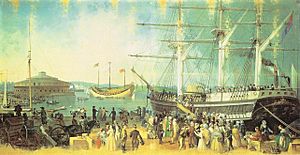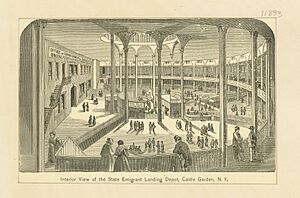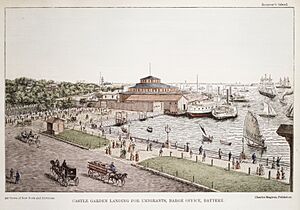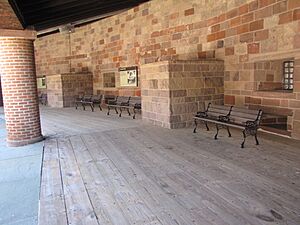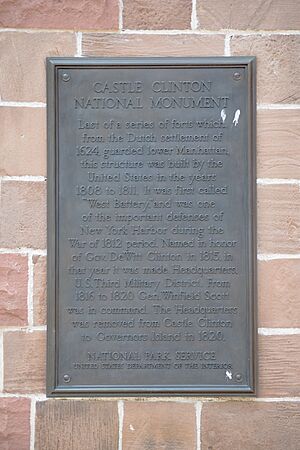Castle Clinton facts for kids
|
Castle Clinton National Monument
Castle Garden |
|
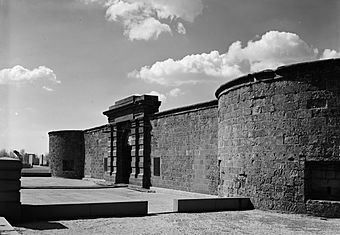
Photo from Historic American Buildings Survey
|
|
| Location | Battery Park, Manhattan, New York |
|---|---|
| Area | 1 acre (0.40 ha) |
| Built | 1808 |
| Architect | John McComb Jr.; Jonathan Williams; U.S. War Department |
| Visitation | 3,471,661 (2022) |
| Website | Castle Clinton National Monument |
| NRHP reference No. | 66000537 |
Quick facts for kids Significant dates |
|
| Added to NRHP | October 15, 1966 |
| Designated NMON | August 12, 1946 |
Castle Clinton is a famous circular fort in Battery Park, at the very tip of Manhattan in New York City. It was built a long time ago, between 1808 and 1811. This fort has had many different lives!
It started as a military fort, but it was never used in a real battle. Later, it became a fun place for concerts and shows. Then, it was the first place where millions of immigrants arrived in the United States. This was even before Ellis Island opened. After that, it became a popular public aquarium. Today, Castle Clinton is a national monument and a visitor center. It helps people catch ferries to the Statue of Liberty National Monument.
Castle Clinton: A Fort with Many Lives
Building a Stronghold
Castle Clinton was first known as the West Battery. It was built on a small artificial island just off the shore of Lower Manhattan. The fort was designed by John McComb Jr. and Jonathan Williams. Construction started in 1808 and finished in 1811.
The fort was round, made of red sandstone from New Jersey. It had 28 cannons to protect New York Harbor. A wooden bridge connected the fort to Manhattan. Even though it was ready for war in 1812, it never saw any fighting. After the war ended in 1815, the fort was renamed Fort Clinton. This was to honor DeWitt Clinton, who was then the Mayor of New York City.
The United States Army stopped using the fort in 1821. In 1822, the city of New York took over the fort.
A Stage for Stars
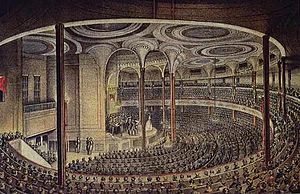
In 1824, the city turned Fort Clinton into an entertainment spot called Castle Garden. It became a place for concerts, shows, and exhibitions. It had 6,000 seats and even a circular walkway on top.
Many famous people visited Castle Garden. In 1824, 6,000 people came to honor General Lafayette, a hero of the American Revolution. U.S. presidents like Andrew Jackson also visited. In 1835, inventor Samuel Morse showed off his new telegraph machine there.
Around 1845, a roof was added to make it a proper theater. In 1850, the famous singer Jenny Lind from Sweden gave her first concerts in the United States at Castle Garden. Tickets were very expensive for these popular shows! Other performers, like the dancer Lola Montez, also entertained crowds.
A Gateway for Immigrants
From 1855 to 1890, Castle Garden became the first official immigration center in the U.S. It processed millions of people arriving in America. Before this, immigrants were often cheated by dishonest agents. Castle Garden was built to protect them.
Immigrants first had health checks on Staten Island. Then, they took a boat directly to Castle Garden. Inside, clerks helped them register and find out about their new destinations. There was a large waiting area with benches. A tall wooden fence kept out people who weren't supposed to be there.
Many records from Castle Garden were lost in a fire later. But it's believed that between 7.5 and 8 million immigrants passed through its doors. Most came from European countries like Germany, Ireland, Italy, and Sweden. This was a huge number of people! In fact, it's estimated that one out of every six Americans today has an ancestor who came through Castle Garden.
How the Immigration Center Worked
The State Emigration Commissioners took over Castle Garden in 1855. They wanted to make sure immigrants were treated fairly. Some people in New York City worried about the immigrants. But a judge said the center could open.
The Emigrant Landing Depot opened on August 1, 1855. It quickly became a busy place. Even though some staff were not always kind, it was still a much better place for immigrants to arrive. It protected them from scams.
Over time, Battery Park was expanded with new land. This connected the island where Castle Garden stood to the rest of Manhattan. By the 1870s, the information office at Castle Garden had staff who could speak more than a dozen languages. This helped immigrants from many different countries.
Challenges and Closure
In 1876, a fire badly damaged Castle Garden's interior. But the outside walls stayed strong. The fort was rebuilt and reopened later that year.
By the late 1880s, Castle Garden became very crowded and dirty. There were also many complaints that officials were treating immigrants poorly. The federal government decided it needed to take over immigration processing. They chose a new location: Ellis Island.
Castle Garden closed as an immigration center on April 18, 1890. The new center on Ellis Island opened in 1892. In its last year, Castle Garden processed over 450,000 travelers. After it closed, the city thought about turning it back into a fun amusement spot.
Underwater Wonders: The Aquarium Years
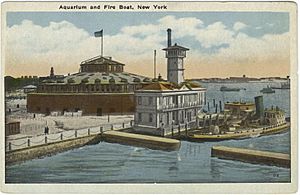
From 1896 to 1941, Castle Garden was home to the New York City Aquarium. The building was changed a lot for this new use. A tall roof was added, but the original fort walls remained.
The aquarium could hold 10,000 fish and other sea creatures. In the middle of the main floor was a large circular pool. Around it were many smaller tanks of different sizes. These tanks were filled with fresh water from the city and salt water from the Hudson River.
Opening and Popularity
The idea for an aquarium at Castle Garden came up in 1891. After some delays and construction issues, the aquarium finally opened on December 10, 1896. It was a huge success! Thousands of people visited on opening day. Since there was no admission fee, it became very popular. Within a year, two million people had visited. By 1900, it had welcomed 5.5 million guests.
Changes and Growth
In 1902, the New York Zoological Society took over running the aquarium. They made many improvements. They added rocks to the tanks and changed the pipes to save energy. They also built a classroom and a large tank to store saltwater.
Over the years, there were plans to expand the aquarium. Officials wanted to add more tanks and classroom space. In the 1920s, the aquarium got a new electric plant and deeper tanks. By then, it was still attracting two million visitors every year.
By the late 1930s, the aquarium's director felt it had grown too big for Castle Garden. He wanted a new building.
Saving History: Preservation Efforts
In 1941, Robert Moses, a powerful city official, announced plans to tear down Castle Garden. This was part of a project to build the nearby Brooklyn–Battery Tunnel. He said the fort was old and needed too many repairs.
But many people wanted to save the fort. The New-York Historical Society suggested turning it into a museum about the sea. George McAneny, a former mayor, also fought to protect it. Moses, however, thought the old fort was not important because it "never fired a shot."
The city closed the aquarium in late 1941. Some fish were moved to other aquariums, and others were released into the ocean. A new aquarium was eventually built on Coney Island in 1957.
The Fight to Save Castle Clinton
In 1942, the city voted to remove the fort. They even tried to sell it. But preservationists kept fighting. They asked judges to stop the demolition. Even though some parts of the fort were removed, it was never fully torn down.
In 1946, a U.S. representative named Sol Bloom introduced a bill to make Castle Garden a U.S. national monument. Both the House and Senate approved it. President Harry S. Truman signed the bill into law. This meant the United States Department of the Interior could take over the fort.
However, the city still owned the land. They wanted the federal government to pay for its restoration. For several years, the city and federal governments argued over who would pay and who would own it.
Finally, in 1949, the New York State Assembly and Senate voted to give the fort to the federal government. Governor Thomas E. Dewey signed the bill. The U.S. House then voted to provide money for the fort's restoration.
On July 18, 1950, the city officially gave the land and fort to the federal government. The National Park Service (NPS) took over. After many years of work, Castle Clinton reopened in 1975. Since 1986, it has served as a visitor center and a place to catch ferries to the Statue of Liberty. It's a great example of how an old building can have many different lives!
|
See also
 In Spanish: Castle Clinton para niños
In Spanish: Castle Clinton para niños


